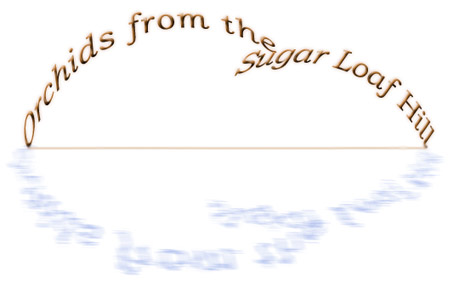
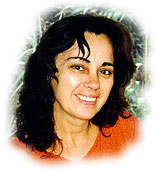


 |
No matter how hostile the environment seems to be, the Sugar Loaf, one of the most known postcards of Rio de Janeiro, is still a habitat of orchids. The most amazing is the occurrence of orchids such as Zygopetalum mackayi, a species of a genus considered as too much difficult to be cultivated.When we look that habitat with those almost barren walls, it is hard to believe that occurs this species which, in other habitats, grown as terrestrial and in very protected humid environment, in high lands, humid steep |
|
banks and sandy grounds of high mountains and coastal woods, since the state
of Espírito Santo, Minas Gerais until Rio Grande do Sul. The occurrence
of Bifrenaria harrisoniae is also curious since we expect to always
find it in the woods of the Serra do Mar, mountains and eyelash woods of
the rivers in the states of Minas Gerais, Espírito Santo and São
Paulo, in high altitude and very humid protected environment. Nevertheless we should point out that there is a small wood at the foothill of Sugar Loaf and the temperature strongly drops down at the night. Many times, in clouded days, the top of the mountain stays involved by fog. Two surveys have been done recently and, in general, the conclusions are the same. The differences concern the extension of the occurrence of the species in the different faces of the hill and do not invalidate neither one nor other work. |

According to the survey done by Francisco E. L. de Miranda and Rogério Ribeiro de Oliveira, at the beginning of the 80th decade, and published in the "Atas da Sociedade Botânica do Brasil", Rio de Janeiro section, eleven rupicolous species of the Orchidaceae family occur in the Sugar Loaf hill. They are: |
| Bifrenaria harrisoniae (Hook.) Reich. f. | |
| Brassavola tuberculata Hook, | |
| Cyrtopodium andersonii R. Br. | probably Cyrtopodium glutineferum Raddi since, nowadays, there is a consensus that the genuine Cyrtopodium andersonii does not occur in Brazil, at least in southeast. |
| Epidendrum denticulatum Barb. Rodr. | |
| Epidendrum robustum Cogn. | To some researchers such as Guido Pabst and Maria da Penha Fagnani, it would be Epidendrum ammophilum Barb. Rodr or even Epidendrum ammophilum Barb. Rodr.var. cariocanum Brade & Pabst. |
| Laelia lobata (Lind.) Veitch. | |
| Maxillaria acicularis Herbert ex Lindley | |
| Polystacha estrellensis Rchb. f. | |
| Prescottia plantaginea Lindley | |
| Sarcoglottis biflora (Vell.) Schltr. | |
| Zygopetalum mackayi Hook. |
| The
survey concerns exclusively the orchids that occur in the rock: the rupicolus
(growing direct in the rocks) or the saxicolas (growing in the organic material
retained on the crevices the rocks). The other terrestrial or dendricola
species that occur in the neighbor woods were not included such as the Vanilla.
This species can be seen along the Cláudio Coutinho way which winds
sinuously the sea, at the foothills of Sugar Loaf and Urca hills. The researchers visited the local monthly to observe the plants in their own habitat and the herborized material has been placed in the Herbarium Alberto Castellanos (FEEMA). |
| The Sugar Loaf hill is 395m above the sea, with a very acid ground and the more steep walls (at about 90º) are the north, west and south faces, the east and nor-east faces have less declivity (between 45º and 60º). |
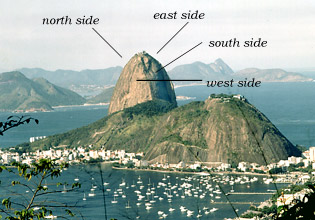 |
All
sides of the hill have been studied and the researchers concluded that the
south face is the one that offers the best conditions for the settlement
of orchids because it presents less sunstroke, during some months of the
year, it does not even receive the sunbeam. Besides it has more capacity to retain humidity on the ground, high declivity and high atmospheric humid provided by the winds. There, Francisco end Rogério verified the occurrence of 9 species, they did not just find Laelia lobata and Cyrtopodium know as andersonni. The west side, which faces the Urca hill (the first stop to get Sugar Loaf hill), is also very rich. |
| In
the north face, they found Polystachya estrellensis and Brassavola
tuberculata that, as it occurs in the Leme hill (object of the Orchid
News 15), growing with the cactaceous of the genus Rhipsalis and
the Bromiliaceae Vriesea brassicoides. That face is the one that
receives more sunbeam. The east face, which receives the morning sunbeam
with a good luminosity all day long, has a less steep wall, allowing a more
fixation of the ground and, as a result, presents more developed vegetation.
There occur Cyrtopodium known as andersonni and Epidendrum
denticulatum. It is interesting to point out that just one specimen of Laelia lobata has been found during their survey, making Francisco Miranda to stay in doubt if the colonization of this species in Sugar Loaf hill is beginning or finishing. Blooming season in Sugar Loaf hill: |
| Months |
Jan
|
Feb
|
Mar
|
Apr
|
May
|
Jun
|
Jul
|
Aug
|
Sep
|
Oct
|
Nov
|
Dec
|
| Bif. harrisoniae |
x
|
|
|
|
|
|
|
|
|
x
|
x
|
x
|
| Bra. tuberculata |
|
|
|
|
x
|
x
|
x
|
x
|
|
|
|
|
| Cyrt. andersonii |
|
|
|
|
|
|
|
x
|
x
|
|
|
|
| Epi. denticulatum |
x
|
x
|
x
|
x
|
x
|
x
|
x
|
x
|
x
|
x
|
x
|
x
|
| Epi. robustum |
|
|
|
x
|
x
|
x
|
x
|
x
|
|
|
|
|
| Laelia lobata |
|
|
|
|
|
|
|
|
|
|
x
|
|
| Max. acicularis |
x
|
x
|
x
|
x
|
x
|
|
|
|
|
|
|
|
| Poly. estrellensis |
x
|
x
|
x
|
|
|
|
|
|
|
|
|
|
| Pres. plantaginea |
|
|
|
|
|
|
x
|
x
|
x
|
|
|
|
| Sarc. biflora |
x
|
|
|
|
|
|
|
|
|
|
|
x
|
| Zyg. mackayi | ||||||||||||
| X = Peak of blooming | ||||||||||||
|
Species listed by G.F. Pabst: |
|
Species
|
Ocurrence
|
| Bifrenaria harrrisoniae (Hook.) Rchb. f. | Praia Vermelha |
| Brassavola tuberculata Hook. | Pão de Açúcar, Praia Vermelha and Pedra da Urca |
| Eltroplectris calcarata (Sw.) Garay & Sweet (sinonimous Centrogenium setaceum (Lindl.) Schltr.) | Pedra da Urca and Praia Vermelha |
| Epidendrum ammophilum Barb. Rodr. | Praia Vermelha and Pedra da Urca |
| Epidendrum ammophilum Barb. Rodr. var. cariocanum Brade & Pabst. | Praia Vermelha and Pedra da Urca |
| Epidendrum denticulatum Rodr. | Praia Vermelha |
| Habenaria leptoceras Hook | Praia Vermelha and Pedra da Urca, |
| Maxillaria funerea Lindl. | Praia Vermelha |
|
Prescottia montana Barb. Rodr. |
Pão de Açúcar |
| Prescottia plantaginea Lindl | Praia Vermelha and Pedra da Urca |
| When we compare those works, we concluded that from the 11 species found by Francisco and Rogério, 5 have been also found by Pabst or examined by herborized material. They are: |
| Bifrenaria harrisoniae | Praia Vermelha |
| Brassavola tuberculata | Pão de Açúcar, Praia Vermelha |
| Epidendrum denticulatum | Praia Vermelha |
| Prescottia plantaginea | Praia Vermelha, Pedra da Urca |
| Epidendrum
robustum, which appears as Epi. ammophilum Barb. Rodr. and as Epi. ammophilum Barb. Rodr. var. cariocanum Brade & Pabst. |
Praia Vermelha |
| So,
the other 6 species mentioned by Francisco and Rogério, Laelia
lobata , Maxillaria acicularis, Polystachia estrellensis, Zygopetalum mackay,
Sarcoglottis biflora e Cyrtopodium glutinniferum were not mentioned
by Pabst as occurring in Sugar Loaf, nor Urca hill, neither Praia Vermelha.
The only mention to Sugar Loaf was the Brassavola tuberculata. We verified the occurrence of Vanilla, along the Cláudio Coutinho Way, at the foothills of Sugar Loaf and Urca hills. We presume that it is Vanilla chamissonis Kl. due to shape of the leaves and due to fact that it is the most common species of this genus occurring in Rio de Janeiro city. |
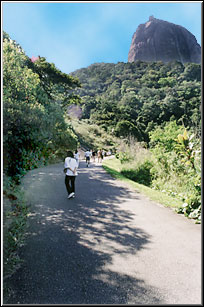 Cláudio Coutinho Way |
|
Ronaldo L. Pangella did his research in Sugar Loaf during since June l993 until November 1995 with the main of illustrate the rupicolous orchids. He based on the work done by Francisco Miranda and Rogério Oliveira. Besides confirming those data, he also got some other results in his search. Overcoming the heat and the difficult of the climbing, he verified all faces of the hill carrying in his knapsack his material to draw and to do some measurements. In the middle of the way, he stopped, took the writing pad and started to do his measurements, his sketches to the study of colors taking, sometimes, it took an hour and half. Those studies were concluded later with the help of the photos he took there. According to him, at the same, he tried to keep his emotional balance because the excitement provoked by finding blooming flowers was really great. However, this excitement dribbled the tiredness, the thirst, the sun and the heat. As time went by, he became more audacious and literally got out of the way of climbing making his climbing more dangerous. |
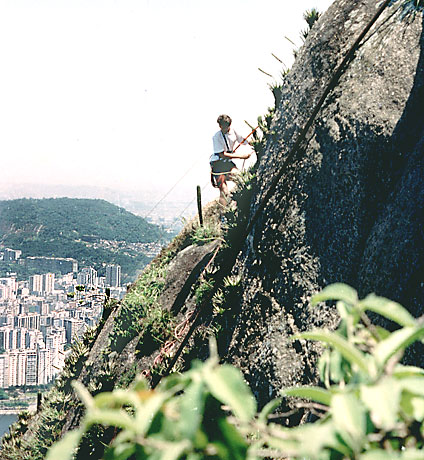 |
In the east face (turned to Baia de Guanabara), Pangella found his first orchid, Epidendrum denticulatum. He noticed that this species is quite common in this side and also in the south face, |
|
|
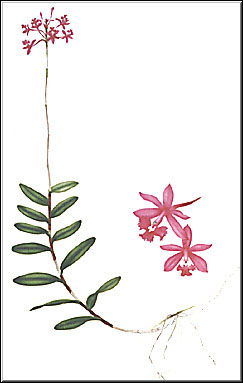 ilustração
de Pangella
ilustração
de Pangella
|
occurring mainly in the inferior third of the hill, in places where the slope is not so sharp. It can appear in the naked rock. and prefers the borders of the community of Velloziacea, Gesneriacceae, Melastomastaceae and Gramineae where there is more sunstroke. It blooms all year along but the peak extends from November to February (later spring and mid summer in south hemisphere). The size of the plant is very variable (since some centimeters). Epidendrum denticulatum fructifies very easily and also presents many keikis developed from the floral spikes. The plant presented here has been illustrated in this face, at 210m altitude. |
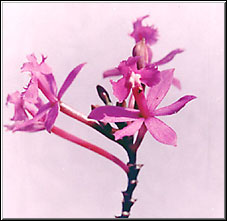 Epidendrum denticulatum |
| In the summit of the hill, next to a colony of Bifrenaria harrisoniae, there is a leafy tree where |
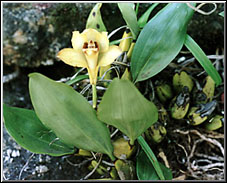 |
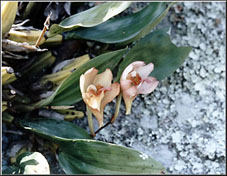 |
| Pangella found an orchid, which has been later, identified by Francisco Miranda as Prostechaea vespa (also known as Anacheillum vespum or Encyclia vespa). |
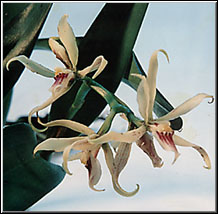 Prostechaea vespa |
| This species appears again in the west face however, growing direct on the rocks. Besides those species, Pangella also found Brassavola tuberculata. |
|
The
south side
(faced to Praia Vermelha, the same side of Cláudio Coutinho way) has different degrees of difficulties and has more than 8 different ways of climbing. |
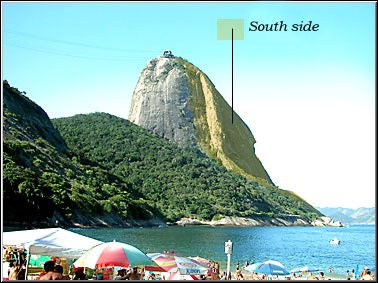 |
| Well
protected from the sun, it is the more humid side. Zygopetalum mackayi Hook occurs encrusted in small crevices of the rocks, encircled by its biggest enemy, Panicum maximum Jacq., the almost natural predator of the orchids, bromeliad and cactaceae. |
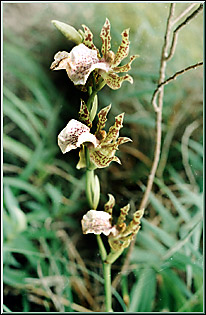 |
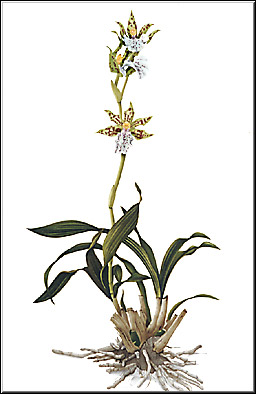 |
| A
colony of Epidendrum first believed as robustum and later rectified
to Epidendrum amophylum lives together with Velloziaceaea
and Bromeliáceas or growing direct on the rock with its long
and vigorous secondary stems. As it is the more shaded place, this species
developed a dark olive green color, making a contrast with the light green
of its petals and sepals. It blooms from April to August. During 5 months,
Pangella return to the place to patiently wait for the blossom. He felt
as receiving a gift with the vision of the colonies of Epidendrum denticulatum
and Epidendrum ammophilum next to Polystachya estrellensis. In a wall not too much steep, in a half shade place, he came upon to Maxillaria acicularis Herbert ex Lindl. A great amount of colonies spreads out for more than 300 m along the rock, associated to bromeliad, gramineae and also Brassavola tuberculata. |
 |
The
colonies of Bifrenaria harrisoniae were spread out along the wall
and the most fascinating of this species is the soft yellow color, green
and olive green shade. It is very common in the south, west and east faces, in every altitude of the hill, in general, in the most inclined walls, especially in this face. l It is often placed in exposed rock or in the borders of the clumps of Velloziaceae, it is rare in places with more associated vegetation. Scent flowers with varied colors and blossom from October to January. |
 |
Although
the literature does not mention the occurrence of Laelia lobata and
Cyrtopodium known as andersonni in this face, justified by the shadow
and constant humidity, Pangella found both species and points out some interesting
points concerning the specimens of Cyrtopodium, which grow in this
place and those which occur in the east face. The pseudobulbs are more vigorous and the leaves present a healthy and perfect exuberance. The flowers are a little bigger and the yellow is more intense. The petals and sepals are back curved. Those plants growing in the east face bloom before those, which grow in the south face. |
| The
Laelia lobata found in Sugar Loaf, with its almost rosy color, differs from those which occur in Pedra da Gávea which have a soft coloring and even "alba" form. The petals and sepals present thin veins. The Laelia lobata illustrated here come from this side. When he confirmed the presence of three species from the eleven listed by Francisco Miranda and Rogério, Pangella named this face as the "Sanctuary", hardly known that, in the future, he would find seven more including Brassavola tuberculata e excluding only Sarcoglottis biflora, not found. |
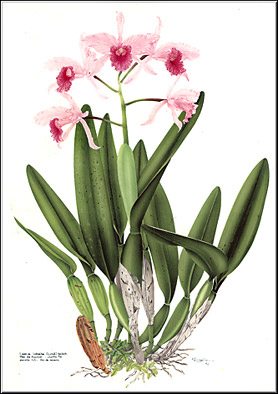 |
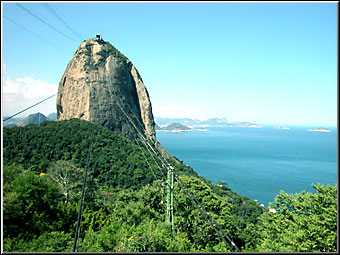 |
The west side (turn to Urca hill) is the most exposed and the wind is almost constantly and lateral. Pangella calls our attention to the fact that it is into two slopes perfectly visible. The inferior is more declined, almost 90 degrees of inclination, where it is possible to find rare plants of Brassavola tuberculata. When the angle of inclination decreases, there is a small cave where is possible to seat down to a deserved rest and admire, at the same time, the beaches of Botafogo, Urca e Vermelha. In this place, he found wonderful specimens of Cephalocereus fluminensis (Cactácea), Clusia sp, (Guttiferae) known as onions of the wood and Tillandsia araujei (Bromeliaceae) and a small colony Laelia lobata, the same former found by Francisco and Rogério. |
| This
colony called the attention by a fragility never found as Laelia lobata,
as any species closed related, in general, presents erect pseudobulds with
a vigorous aspect. All pseudobulbs were wrinkled, twisted and yellowish,
the colony does not reach 30cm. It is completely exposed to the sunbeam
and does not bloom since 15 years ago. Bifrenaria harrisoniae has been considered as the most dangerous to be illustrated, placed in a small plateau of veins of quartz, almost at 300m altitude. Besides Epidendrum denticulatum, another colony of Zygopetalum mackayi as well as Prostecheae vespa growing on the rocks. |
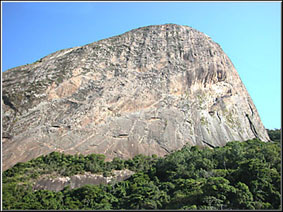 |
The
north face was not researched because Pangella did not find anything representative, just small colonies of Brassavola tuberculata. |
| Any kind of reproduction (print, digital or anyone other) of any type of material of this site - texts, lay-out, photos, images and others - is strictly forbidden without the previous written permission of the authors. Any solicitation or information by the e-mail: bo@sergioaraujo.com |